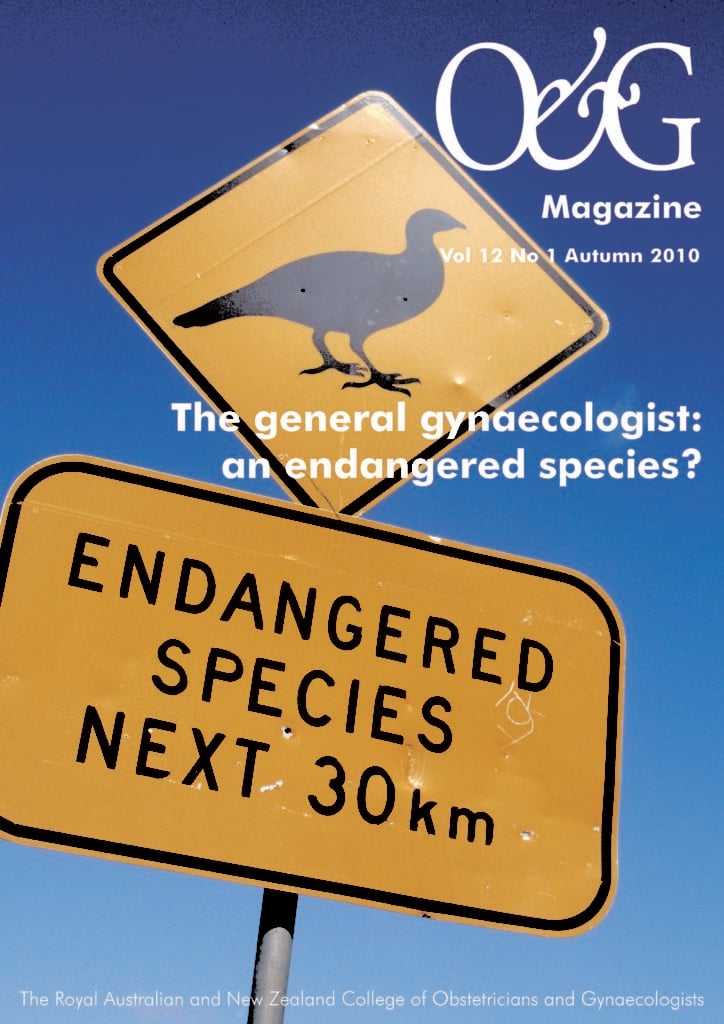Whilst some obstetrician/gynaecologists choose to focus on very narrow aspects of our specialty, others maintain a broader interest. The potential to remain general and all of the skill this requires is a major factor in the popularity of the specialty. Historically, that ‘generalism’ was reflected in a ‘jack-of-all-trades’ approach, the gynaecologist undertaking whatever came their way: one day a simple hysterectomy, the next a radical vulvectomy.
This practice began to change as evidence accumulated that women with ovarian cancer, in particular, have improved survival if operated on by a trained subspecialist – the gynaecological oncologist.1,2 This realisation led to general acceptance that women suffering from advanced ovarian malignancy should be referred to a gynaecological oncologist.
The fact that some data show improved outcomes for adequately debulked epithelial ovarian cancer treated by a subspecialist does not necessarily mean all gynaecological malignancies benefit from subspecialist referral. Furthermore, even for ovarian cancer, some data suggest outcomes for women treated by specialists and subspecialists are almost identical in the long-term.3
Conflict thus exists between these polarised views. On one hand is the expectation that all women with gynaecological malignancy or possible malignancy are referred to the subspecialist. On the other, many non-subspecialists continue to treat women with certain cancers or potential cancers. Determining the most appropriate management within these diverse views is difficult because there remain several areas of uncertainty and controversy:
- Should all women with early endometrial cancer undergo lymphadenectomy when long-term survival may not be improved?4
- Should the woman with endometrial hyperplasia with atypia found on sampling also be referred to the subspecialist, given over a 40 per cent chance of concomitant malignancy in some studies?5
- What is the best management of the perimenopausal woman with a small complex ovarian cyst, no significant family history and borderline tumour markers? Whilst the likelihood of cancer in such a case is small, the woman’s outcome may be worsened if primary surgery is less complete, for example by inclusion of lymph node sampling.6
- For the uncertain ovarian cyst, is the balance of risk in favour of radical surgery with pelvic clearance and lymph node sampling by a subspecialist, or in favour of a laparoscopic excision by a general specialist and histological assessment to determine the need for more radical surgery at a later date?
It could be argued that all of these clinically common situations are the domain of the subspecialist. Certainly, in some countries, notably the united Kingdom, that is the trend. The vast majority of the RANZCOG Fellowship is non-subspecialist, with less than three per cent being gynaecological oncologists. Is it practical to have specially trained clinicians operating on women with a low likelihood of malignancy? This may simply preclude women in need of urgent surgery from accessing special skills promptly.
Particularly for rural patients, transfer to a subspecialist may bring with it substantial inconvenience and psychosocial stress. The cancer centre/cancer unit model adopted in the United Kingdom is probably impractical in Australia, with its distances and differences in practice models. On the other hand, the highly experienced specialist is perhaps on the way out, with concerns expressed over the level of surgical skills of trainees.7
In my opinion, decisions regarding optimal management of a woman with proven or suspected gynaecological malignancy require a practical case-by-case patient-centred approach. The ideal would be for the specialist to be able to discuss the details of an individual woman at a multidisciplinary tumour board. Such review would facilitate an integration of:
- The skills and experience of the gynaecologist involved:
It is clearly different if the gynaecologist has 30 years experience with a special interest in oncology, or is three months since elevation to Fellowship with experience of less than ten hysterectomies. - The social circumstances and wishes of the patient:
For many patients, the therapeutic relationship with their life-long gynaecologist may outweigh small potential advantages of transfer to a subspecialist. - The accessibility of a subspecialist:
The subspecialist may not be able to undertake the hysterectomy for early endometrial cancer for six weeks, when the referring gynaecologist could do it tomorrow. - The support services available locally:
Social workers, oncology nurses, etc. - The clinical details of the case:
Previous surgery, depth of invasion, obesity, etc.
In some circumstances, there is less room for debate: the morbidity of radical vulvectomy or the need for vascular surgical support clearly favour transfer of women with vulval and cervical cancers, for example. However, the many other areas of controversy require discussion. Although much effort has been put towards trying to assess likelihood of malignancy using various criteria8, these tools fail to take into account the circumstances of the patient.
and a pragmatic acceptance by the subspecialist that not all cases need be undertaken by themselves, would serve patients well.
A woman with a moderate risk of malignancy index score may ideally be referred, but if she lives 500km away from the nearest subspecialist, that may be impractical. This case may be better dealt with by discussion between specialist and subspecialist, leading to a cohesive plan of management.
The integrated approach, with easy access to a subspecialist opinion and a pragmatic acceptance by the subspecialist that not all cases need be undertaken by themselves, would serve patients well. The gynaecologist wants to be able to discuss the details of the case and receive balanced advice. In return for this consultation, the subspecialist should appropriately triage cases and only take over care where there is a clear advantage to the patient. If transfer is agreed, this should be followed by timely communication about procedures and outcomes.
A patient-centred approach is also required for follow-up. The benefit of follow-up is unclear, but it is often undertaken in the unsubstantiated belief, by patients and clinicians, of improving survival. For most gynaecological cancers, there is little evidence of a survival advantage to regimented follow-up and there are possible negative implications for the woman and her family. Early detection of recurrence may simply mean the woman lives the same amount of time with more of it spent in the knowledge that she is terminally ill! Transfer of the woman back to the referring gynaecologist should be routinely considered. Some patients will feel more reassured by subspecialist review, others won’t. Thus the patient’s wishes should be taken into account.
On occasions, even if the risk of malignancy seemed low, the gynaecologist may be faced with malignancy in unexpected circumstances: the 30-year-old woman with a torted ovarian cyst removed laparoscopically that turns out to be malignant, as an example. unfortunately, when this woman is subsequently referred to the subspecialist, she may be given the impression that the referring specialist ‘did the wrong thing’. This sort of criticism seems disappointingly common, is unhelpful and profoundly unprofessional.
In summary, the gynaecologist will continue to be faced with women with gynaecological cancer. Many cancers require transfer to the subspecialist for multidisciplinary team care and advanced surgical skills. There are simply not enough subspecialists, however, to care for all women with cancer or potential cancer. Furthermore, there isn’t the evidence in all circumstances that subspecialist care improves outcomes. If the evidence changes in support of all forms of potential or actual cancer benefiting from subspecialist care, routine referral should be supported. until then, a pragmatic team approach seems to offer the best for our patients.
Conflict of interest: I am a non-subspecialist!
References
- Junor EJ, Hole DJ, McNulty L, Mason M, Young J. Specialist gynaecologists and survival outcome in ovarian cancer: a Scottish national study of 1866 patients. British Journal of Obstetrics and
Gynaecology 1999; 106: 1130-6. - Vernooij F, Heintz AP, Witteveen PO, van der Heiden-van der Loo
M, Coebergh JW, van der Graaf Y. Specialized care and survival of ovarian cancer patients in the Netherlands: nationwide cohort study. Journal of the National Cancer Institute 2008; 100: 399-406. - Earle CC, Schrag D, Neville BA, et al. Effect of surgeon specialty on processes of care and outcomes for ovarian cancer patients. Journal of the National Cancer Institute 2006; 98: 172-80.
- Kitchener H, Swart AM, Qian Q, Amos C, Parmar MK. Efficacy of systematic pelvic lymphadenectomy in endometrial cancer (MRC ASTEC trial): a randomised study. Lancet 2009; 373: 125-36.
- Trimble CL, Kauderer J, Zaino R, et al. Concurrent endometrial carcinoma in women with a biopsy diagnosis of atypical endometrial hyperplasia: a Gynecologic Oncology Group study. Cancer. 2006; 106: 812-9.
- Camara O, Sehouli J. Controversies in the management of ovarian cancer – pros and cons for lymph node dissection in ovarian cancer. Anticancer Research 2009; 29: 2837-43.
- Obermair A, Tang A, Charters D, Weaver E, Hammond I. Survey of surgical skills of RANZCOG trainees. The Australian & New Zealand Journal of Obstetrics & Gynaecology 2009; 49: 84-92.
- van den Akker PA, Aalders AL, Snijders MP, et al. Evaluation of the risk of malignancy index in daily clinical management of adnexal masses. Gynecologic Oncology 2009.






Leave a Reply